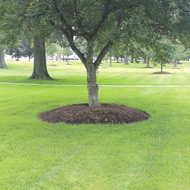Threats to trees are humans with equipment Taking care of ... TREES

Threats to trees are humans with equipment
Taking care of ...
TREES
Protect and preserve these growing assets
By SARA SCUDIER
OSU Ext. Master Gardener Volunteer
CANFIELD
One of the most-dangerous pests of trees is humans, especially humans with equipment.
Lawn mowers and weed trimmers can cause injuries that create a hazard when an injury leads to tree disease or death.
Here’s why the damage is so dangerous and some ways to protect your trees. The site of injury is usually the root flare: the area where the tree meets the turf and gets in the path of the mower or trimmer.
The root flare, like the rest of the trunk, is protected by bark, which guards the nutrient and water-transport system between the roots and leaves to keep the tree alive.
Any damage to this transport system can affect tree health, and the tree could die. The bark layer can vary in thickness on different tree species. It can be more than an inch in thickness or less than 1/16 of an inch on young, smooth-barked trees such as maples and birches. This isn’t much protection against string trimmers and mowing equipment, especially on young, newly planted trees.
Even when a tree tries to recover from a wound, leaves and branches often decline and die back, because food and water pathways were destroyed.
Although a large wound is generally more serious than a smaller one, repetitive wounding adds up to greater trouble for the tree.
If the damage extends completely around the base of the tree – this situation is called girdling – the tree ultimately dies. No matter what size the wound is, the damage done is irreversible.
The wounded area is an opening for wood-rotting organisms and decay fungi to enter and cause further damage by attacking the injured bark and invading adjacent healthy tissue, greatly enlarging the wound and extending the damage.
Some easy methods to help prevent injury are to remove turf or prevent grass and weeds growing at the base of the tree.
A mulch ring helps reduce competition for water and nutrients. Add a 2- to 3-inch layer of mulch on the root zone of the tree to provide an attractive and healthy environment for the tree to grow.
This also provides a visual cue to keep equipment away from the tree.
Trees are a valuable asset to your property and are important to our environment. Every tree contributes to the urban forest and improves air and water quality in your neighborhood.
Protect and preserve these growing assets by keeping mowing and weed-trimming equipment away from tree trunks. Remember: The damage lasts, and it cannot be undone.
 43
43
